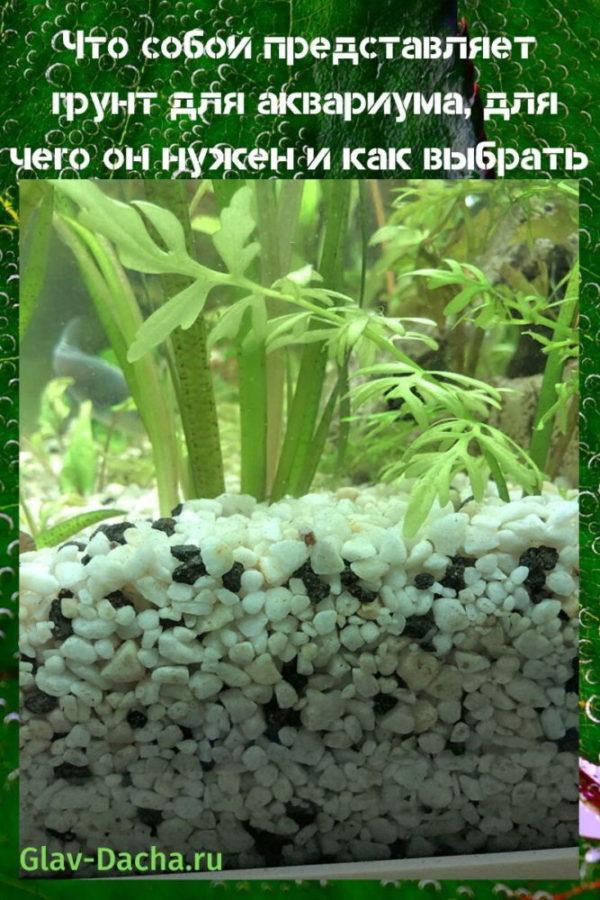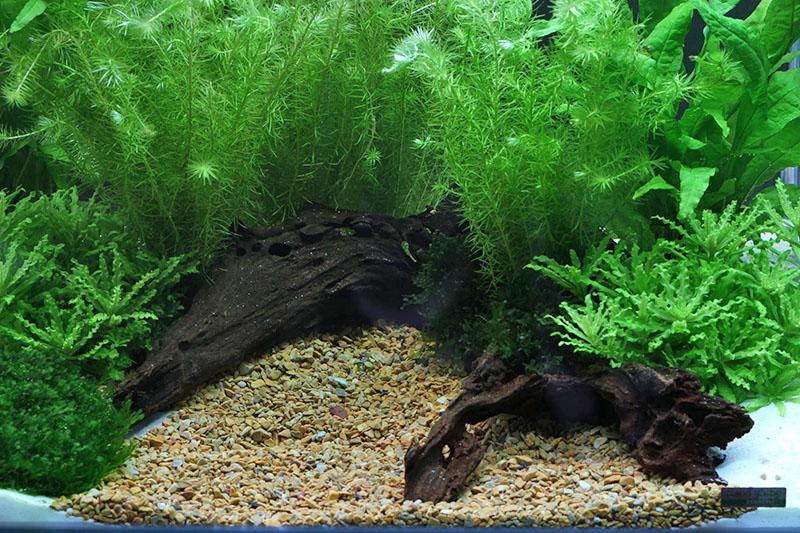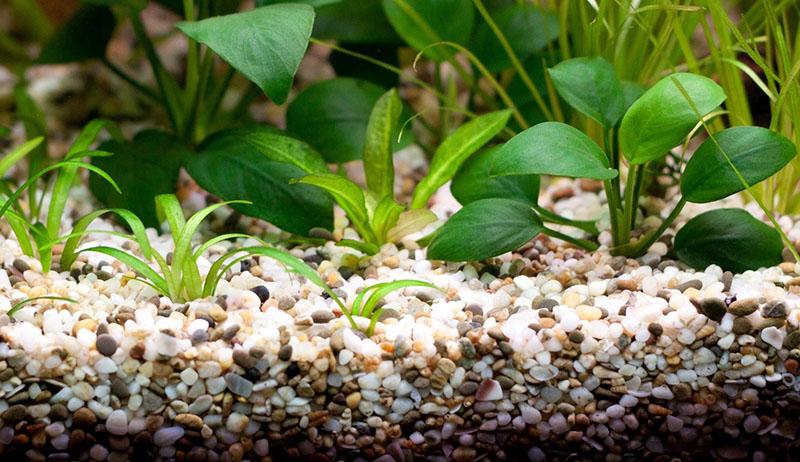What is aquarium soil, what is it for and how to choose
 Aquarium soil is not just a design element. This is a full-fledged part of the ecosystem, without which life in a closed aquarium space is impossible. Choosing it based on its appearance is the same as equipping your own apartment, focusing on the beauty of the working material.
Aquarium soil is not just a design element. This is a full-fledged part of the ecosystem, without which life in a closed aquarium space is impossible. Choosing it based on its appearance is the same as equipping your own apartment, focusing on the beauty of the working material.
Aquarium soil: definition, necessity

In a “fish house”, bottom flooring is necessary because:
- he is a processor of fish waste;
- contributes to the saturation of water with oxygen;
- natural filter for pollutants;
- vital for bottom fish;
- power source for plants.
The fact is that beneficial bacteria and microorganisms live on the surface of the substrate, multiplying. They are responsible for the first three points listed above.
How to choose a soil
 Arriving at a pet store, a beginner - aquarist has a desire to buy all the most beautiful. The same applies to the ground, most importantly, its appearance. In fact, the attractiveness of the substrate is a secondary matter.
Arriving at a pet store, a beginner - aquarist has a desire to buy all the most beautiful. The same applies to the ground, most importantly, its appearance. In fact, the attractiveness of the substrate is a secondary matter.
When choosing it, pay attention to the following things:
- a type;
- size and shape of the fraction;
- color.
 First of all, you need to decide on the purpose of the aquarium. For small, viviparous fish, one type of soil is suitable, for large predators - another, and for a paludarium (aquarium for growing plants) - completely different.
First of all, you need to decide on the purpose of the aquarium. For small, viviparous fish, one type of soil is suitable, for large predators - another, and for a paludarium (aquarium for growing plants) - completely different.
For turtles and miniature crocodiles, only a large composition is suitable. Preferably pebbles or large stones.
Aquarium soil: types

The aquarium substrate is divided into several types:
- natural;
- natural but processed;
- artificial.
Natural bases include pebbles, river sand, stones, gravel.
Treated soils: painted gravel and stones, expanded clay.
Artificial substrates - glass stones, processed plastic.
Advantages and disadvantages of natural soil
 Beginners and professionals are more willing to choose a natural substrate because of its presentable appearance, large selection, and affordability.
Beginners and professionals are more willing to choose a natural substrate because of its presentable appearance, large selection, and affordability.
Positive aspects of aquarium filling with natural soil:
- chemically neutral, which means that the substrate does not change the pH of the water;
- easy to care for with a siphon;
- good for the growth of beneficial bacteria.
Disadvantages of the substrate:
- As an independent unit, not suitable for plant growth. A special backing must be used.
- The coarse fraction is not suitable for a bottom fish tank. These underwater inhabitants love to bury themselves in the ground, it is better to choose sand for them.
Treated soil for aquarium
 This type of substrate looks beautiful in a tank. However, chemically colored soil adversely affects fish health by releasing unhealthy substances. White, dyed elements turn to dirty - milky or gray over time.
This type of substrate looks beautiful in a tank. However, chemically colored soil adversely affects fish health by releasing unhealthy substances. White, dyed elements turn to dirty - milky or gray over time.
As for expanded clay, its composition is suitable for fertilizing plants, helps to fight the growth of algae.
For beginners - aquarists it is better to pay attention to natural soil. The processed one is quite capricious, requires scrupulous care.
Artificial ground
 Painted pebbles made from plastic chips look good in a fish house.This type of soil is easy to care for, it does not change the pH of the water. Over time, the paint starts to creep off the plastic. The base loses its appearance, and the paint can hardly be called useful for aquarium inhabitants. In addition, plastic pebbles are not suitable for planting plants, they do not have biological value for the ecosystem of an artificial reservoir. Beneficial bacteria and microorganisms do not live on it.
Painted pebbles made from plastic chips look good in a fish house.This type of soil is easy to care for, it does not change the pH of the water. Over time, the paint starts to creep off the plastic. The base loses its appearance, and the paint can hardly be called useful for aquarium inhabitants. In addition, plastic pebbles are not suitable for planting plants, they do not have biological value for the ecosystem of an artificial reservoir. Beneficial bacteria and microorganisms do not live on it.
Glass stones, like pebbles, are the decoration of the tank. Glasses do not carry any benefit, except for an ethetic appearance.
Fraction size and shape
 The circulation of water and nutrients dissolved in it depends on the size of the fraction. The smaller the soil, the higher the risk of the formation of stagnant zones without oxygen. In such zones, hydrogen sulfide is formed, because the fine composition is very difficult to clean. It accumulates the remains of fish feed, waste of their vital activity. As a result, all this begins to rot, the water acquires a disgusting smell, and the fish die from suffocation.
The circulation of water and nutrients dissolved in it depends on the size of the fraction. The smaller the soil, the higher the risk of the formation of stagnant zones without oxygen. In such zones, hydrogen sulfide is formed, because the fine composition is very difficult to clean. It accumulates the remains of fish feed, waste of their vital activity. As a result, all this begins to rot, the water acquires a disgusting smell, and the fish die from suffocation.
Getting rid of hydrogen sulfide is described below, an example of the danger of shallow soil is given here. On the other hand, small fish do not need a large substrate. Most aquariums use soil that is 0.5-3 mm in size.
A visual table with fractions and their use in various "fish houses":
| Fraction size | Purpose |
| 0.1 mm - 1 mm | Suitable for small tanks with small and bottom fish |
| 1 - 5 mm | Good substrate for aquariums with a large number of live plants, small and medium-sized fish |
| 6-12 mm | Ideal for large fish and turtles. |
Substrates larger than 12 cm are only suitable for very large tanks and giant fish. For example, for the content of the arowna.
Soil color
 Many novice aquarists believe that the soil should be bright and beautiful. When they arrive at the pet store, they opt for bright orange, reds, blues and purples. And others believe that dark colors contribute to warming the bottom, plants love them very much. This is a lie, plants do not care what color the bottom flooring is, they need the nutrients from it.
Many novice aquarists believe that the soil should be bright and beautiful. When they arrive at the pet store, they opt for bright orange, reds, blues and purples. And others believe that dark colors contribute to warming the bottom, plants love them very much. This is a lie, plants do not care what color the bottom flooring is, they need the nutrients from it.
Multi-colored soil for the tank is bad because poor-quality paint can gradually dissolve under the influence of water. This means that she slowly but surely poisons fish with chemistry. This is not good for aquatic life. Such a reservoir risks turning into a large graveyard for fish.
It is advisable to give preference to a natural substrate of natural colors: brown, gray, yellowish. And it is better to refrain from acquiring a white base, for it quickly loses its original beauty.
External and internal soil structure
 The rounded bottom deck is ideal for fish. Catfish living at the bottom of the tank will be able to burrow into it without risking damage from sharp corners. The rest of the aquarium inhabitants will keep the body and gills intact.
The rounded bottom deck is ideal for fish. Catfish living at the bottom of the tank will be able to burrow into it without risking damage from sharp corners. The rest of the aquarium inhabitants will keep the body and gills intact.
Sharp soil, especially the fine fraction, can damage not only scales and gills. Fish are able to swallow it, and the sharp edges will damage their digestive system.
As for the internal structure of the soil, it must be porous. It is in porous compositions that beneficial bacteria and microorganisms nest. Substrates with a smooth inner surface do not hold them, which means they are not useful for aquarium plants.
Based on the foregoing, when choosing a substrate for an aquarium, you should give preference to a natural, medium fraction, with smooth edges.
Useful Tips
Common questions from newbies:
- Can cat litter be used as aquarium soil?
- Is garden soil suitable?
- Why are glass stones bad?
- Is pH change in an aquarium dangerous?
- The aquarium smells like rotten eggs, what should I do?
- How do I clean the bottom layer of my aquarium?
- How many times a year should the bottom deck be cleaned and replaced?
- How to properly lay the substrate in the aquarium?
- What is underlay?
- Can river sand be used?
- Do I need to rinse it after purchase? What soap?
There are not many questions, but they require detailed consideration.
Cat litter as a base
 It is strictly forbidden to use silica gel or corn cat litter. Such a bottom flooring will kill fish; beneficial microorganisms that settle on the silica gel do not stay on it. In addition, this type of filler releases substances that are in no way compatible with the "fish kingdom".
It is strictly forbidden to use silica gel or corn cat litter. Such a bottom flooring will kill fish; beneficial microorganisms that settle on the silica gel do not stay on it. In addition, this type of filler releases substances that are in no way compatible with the "fish kingdom".
Garden substrate
 Garden soil leads to rapid water oxidation. As a result, decay begins, which is detrimental to plants and fish.
Garden soil leads to rapid water oxidation. As a result, decay begins, which is detrimental to plants and fish.
Glass stones
 Despite their attractiveness, they are not suitable as aquarium substrate. Glass is devoid of internal porosity; plants will not take root in it. Can only be used in an aquarium if no plants are available.
Despite their attractiveness, they are not suitable as aquarium substrate. Glass is devoid of internal porosity; plants will not take root in it. Can only be used in an aquarium if no plants are available.
About pH in the aquarium
 The pH level is a value that shows the degree of concentration of hydrogen ions and hydroxides in water.
The pH level is a value that shows the degree of concentration of hydrogen ions and hydroxides in water.
If the pH is <7, this indicates that the water in the aquarium is acidic, at pH> 7 it is alkaline. The pH level is influenced by aquarium soil made of marble or shells. It contains calcium carbonate, which dissolves in water and increases the pH of the medium.
You can check for the presence of calcium carbonate in the soil. For this, table vinegar is taken, a small amount is poured onto the substrate. Foam is indicative of calcium carbonate.
About hydrogen sulfide
 Hydrogen sulfide appears in aquariums with very small soil sizes. Why this happens is described in the subsection “size and shape of the fraction”. The presence of hydrogen sulfide is characterized by the smell of rotten eggs from the aquarium.
Hydrogen sulfide appears in aquariums with very small soil sizes. Why this happens is described in the subsection “size and shape of the fraction”. The presence of hydrogen sulfide is characterized by the smell of rotten eggs from the aquarium.
To get rid of its accumulation, you must:
- transplant fish and plants into another container;
- carefully drain the water;
- get the soil, put it in a deep basin;
- rinse under running water several times;
- boil for 20 minutes;
- let cool;
- put back in the aquarium.
After the performed manipulations, fill the soil with settled water (at least three days). Plants and fish can be returned to their original place of residence.
If there is no time or opportunity to settle the water, you can use a special conditioner to purify it.
Cleaning the bottom deck
 The soil for the aquarium, using a siphon, is cleaned once a week. You can use both the simplest manual siphon and the automatic one.
The soil for the aquarium, using a siphon, is cleaned once a week. You can use both the simplest manual siphon and the automatic one.
As for the general cleaning in the aquarium, it is carried out once every six months. They completely change the soil once a year (in medium-sized aquariums) or at three years (in large).
If the soil is not cleaned on time, algae will begin to grow abundantly in the aquarium. It is very difficult to get rid of them, so it is worth keeping the substrate clean.
How to lay soil in an aquarium
 The substrate is laid in a slide. The main part begins at the back wall of the tank, the layer thickness is from 5 to 8 centimeters, depending on the volume of the "fish house". The closer to the front wall, the thinner the layer.
The substrate is laid in a slide. The main part begins at the back wall of the tank, the layer thickness is from 5 to 8 centimeters, depending on the volume of the "fish house". The closer to the front wall, the thinner the layer.
When laying the substrate, it is necessary to monitor its even distribution along the bottom. There should be no empty spaces, no "bald spots".
The laid soil is poured as follows:
- Place a saucer or large plate in the middle of the container.
- Pour the settled water in a thin stream into the center of the saucer.
- Water should flow evenly along its edges, cover the surface.
- When the water level reaches the middle of the container, remove the plate.
- Water continues to be poured in a thin stream until its level rises almost to the edge of the aquarium. There should be about 5 cm before it.
If water, without observing these rules, is simply poured onto the soil, it will scatter over the tank. Instead of a beautiful design, something incomprehensible will turn out, the water will become cloudy.
Substrate under the ground
 A nutrient substrate is essential for planting. There are pads for beginners and professionals.
A nutrient substrate is essential for planting. There are pads for beginners and professionals.
In fact, the nutrient substrate is a clay, peat or vermicompost substrate.Such a substrate is used to nourish the roots and stimulate plant growth, put it under the main soil.
The nutrient medium is not used in a tank with a small amount of vegetation.
River sand as a nutrient layer

Natural soil is an opportunity to save money on its purchase. However, when choosing gravel or river sand as a substrate for your aquarium, you need to know that:
- You can collect it in an ecologically clean area. A public beach is not the best place to collect aquarium soil.
- You can not take sand of red or rich yellow colors. It contains iron oxide, which is extremely harmful to fish.
Do I need to rinse the soil after purchase
 Having bought soil, beginners tend to immediately put it in the "fish house". And then they wonder why the water has become cloudy, the plants do not take root, and the fish have died.
Having bought soil, beginners tend to immediately put it in the "fish house". And then they wonder why the water has become cloudy, the plants do not take root, and the fish have died.
Rinse the aquarium filler before placing it. This is done in an elementary way:
- Put the soil in a large basin. It is better to spread in small portions, rather than all at once.
- Rinse thoroughly under running water.
- Take out the washed substrate, put in a deep saucepan.
- Put on medium heat, bring to a boil.
- Boil for 15-20 minutes.
- Allow to cool.
Of course, only natural bases are washed this way, including those collected on their own. The artificial substrate can simply be rinsed in running water and dried thoroughly.
With regard to the use of chemicals, it is better to refrain from this. Some beginners try to wash the soil for the aquarium with zoo shampoo, you should definitely not take an example from them. Also, it is not washed with laundry soap, powder (for example, baby) and dish detergent.
Much depends on the correct composition and timely care for it. A natural substrate is suitable for a real aquarium with plants and numerous fish.